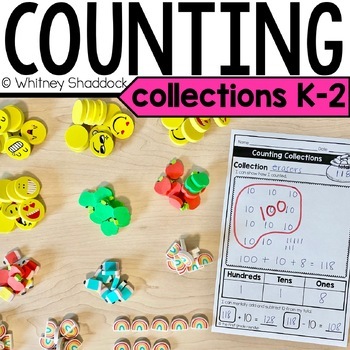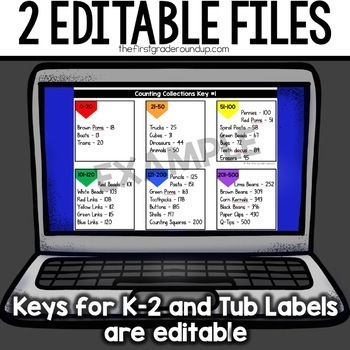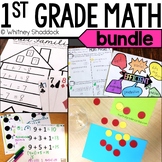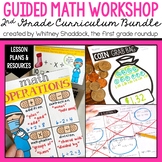Counting Collections for Primary Grades Activities
- Zip
What educators are saying
Also included in
- It's hard to find a 1st grade math curriculum that is rigorous AND engaging! Look no further! This first grade guided math curriculum has 1st grade math lesson plans already written for you plus all the materials needed to implement guided math workshop right away.WHY GUIDED MATH WORKSHOP?Many teachPrice $159.00Original Price $221.00Save $62.00
- Have kids that need extra practice counting, skip-counting, writing numbers correctly or need a better understanding of base 10? Counting Collections is the perfect activity for developing a solid foundation in number sense. This bundle includes the original and best-selling Counting Collections rPrice $18.00Original Price $22.50Save $4.50
- Do you feel lost planning second grade math each week? Do you feel like you have some good pieces or parts of your 2nd grade math curriculum, but you can't seem to fit them all in or make them all work together? Guided math workshop is for you! WHY GUIDED MATH WORKSHOP?Many teachers and districtsPrice $149.00Original Price $212.50Save $63.50
Description
Do you have kids that need extra practice counting, skip-counting, writing numbers correctly or need a better understanding of base 10? Counting Collections is the perfect activity to help kids build number sense.
What is Counting Collections?
Counting Collections is a K-2 counting routine that gives kids authentic opportunities to count objects. Because it's a routine, students only have to learn what to do once. And then we can repeat the routine monthly, weekly, or even daily depending on kids' needs with a new tub of objects!
Why should I do Counting Collections?
Counting Collections helps kids build number sense and base 10 understanding. The more kids count objects, they begin to realize that counting objects in groups of 5s or 10s or even 100s is more efficient. This leads to a powerful visual of place value and base 10 understanding and gives K-2 kids a strong math foundation.
INCLUDED IN THIS COUNTING & NUMBER SENSE RESOURCE
(Separate resources for K, 1st and 2nd are included for each item)
- Common Core Standards covered each week during Counting Collections (at least 13 K-2 standards are met with this routine!)
- Lesson plans for the first day and how to successfully launch Counting Collections in your classroom
- Lesson plan format instructions and details to be followed during your weekly counting collections routines.
- Mini Lesson focus ideas/goals for Counting Collections
- Counting Assessments for K-2 with teacher recording sheets, student materials, rubrics, and weekly anecdotal records to document growth (download the preview to see all the details of what is assessed and when)
- Counting Collections checklist for self-assessment
- Counting Collection Keys for K-2- list of items and how many to put in each collection. These are only suggestions. There are also blank keys so you can fill in your own collections. **I have a separate EDITABLE pdf for each of these keys as well.**
- Counting Tub Labels (if you use the same collections I used.) **EDITABLE label pdf to make your own!**
- Student recording sheets for K, 1st and 2nd. (Full page and half page sizes included.)
- Anchor chart template for Counting Collections in color and BW
- Tons of how to use this resource pages with photos!
How can I use Counting Collections?
This routine can be used in lots of ways in the K-2 classroom, including...
- monthly, weekly, or daily math lesson partner work
- math center rotations
- small group math interventions for kids struggling with counting
TEACHERS LIKE YOU SAID…
⭐️⭐️⭐️⭐️⭐️ "I love using counting collections in my primary classroom and this resource was an amazing compliment to the framework I had set up in my classroom. The students are highly engaged in using the resource and it gives them a tool to organize their math thinking. Highly recommend!" ~Sara
⭐️⭐️⭐️⭐️⭐️ "This was a great hands on resource for all my students no matter their learning level, style, or native language. The whole class loved this!" ~Mike
⭐️⭐️⭐️⭐️⭐️ "This has been a game changer for my math centers. Very straight forward and easy to use. I appreciate the assessment component." ~Lindsey
⭐️⭐️⭐️⭐️⭐️ "This resource was exactly what I was looking for! It was easy to set up and implement in my classroom and my students were very engaged. It was easy to adapt for my students who needed accomodations/modifications. Perfect for a kinder classroom!" ~Amber
You may also like...
→ Daily Math Calendar and Skills Interactive Powerpoints
→ First Grade Math Lesson Plans
Having difficulty with a file?
Visit the FAQs section, submit a help ticket, or ask a question on the Q&A tab before leaving feedback.
___________________________________
Copyright © The First Grade Roundup by Whitney Shaddock.
Permission to copy for single classroom use only.
Please purchase additional licenses if you intend to share this product.
LET'S CONNECT








